Short video update
This aquarium houses dwarf species, like fish, shrimps and snails (excluding plant sp.). As well as that it's a home of diverse micro life forms, including algae, fungus, microorganisms and bacteria.


 This Betta wasn't part of my plan for this dwarf species aquarium, but it happened and here it is :-) This was the only aquarium suitable for him. Anyway, I need some sort of predator since my Red Cherry Shrimps are breeding like crazy, and this aquarium is over-populated with shrimps. I don't sell shrimps privately and have no one to give them to, so this absolutely gorgeous Crown-tail will have something to do for some time.
This Betta wasn't part of my plan for this dwarf species aquarium, but it happened and here it is :-) This was the only aquarium suitable for him. Anyway, I need some sort of predator since my Red Cherry Shrimps are breeding like crazy, and this aquarium is over-populated with shrimps. I don't sell shrimps privately and have no one to give them to, so this absolutely gorgeous Crown-tail will have something to do for some time.
I added Active Carbon to the Filter system to remove everything that might possibly hurt the shrimps and fish. Since I experienced a few shrimp deaths, I had to do something. I believe this was the best solution.
The Staghorn algae;



 This aquarium got suddenly infested with this threaded Staghorn algae. It is only growing on Microsorum leaves and on the filter out-let. Shrimps don't show any appetite towards this type of algae. After two days of observations I have found the culprit. Algae infected only the old Microsorum leaves. So, I pruned off the infested leaves. I am not sure will this algae show up again, since my shrimp population has tripled (possible ammonia), but time will tell.
This aquarium got suddenly infested with this threaded Staghorn algae. It is only growing on Microsorum leaves and on the filter out-let. Shrimps don't show any appetite towards this type of algae. After two days of observations I have found the culprit. Algae infected only the old Microsorum leaves. So, I pruned off the infested leaves. I am not sure will this algae show up again, since my shrimp population has tripled (possible ammonia), but time will tell.
 I didn't clean the back glass for a while and of course it is now covered in Green Spot algae so badly that it looks like a carpet. I tried to scrape it off with a razor blade but no luck...way too hard. I introduced one Zebra snail and already after one day the glass looks much better.
I didn't clean the back glass for a while and of course it is now covered in Green Spot algae so badly that it looks like a carpet. I tried to scrape it off with a razor blade but no luck...way too hard. I introduced one Zebra snail and already after one day the glass looks much better.
 I have noticed Crystal Red shrimplets about a month ago, but never had an opportunity to make a good shot really, until now. Since this tank is fully planted it is hard to see all the shrimp babies. I can count around 10 shrimplets at a time.
I have noticed Crystal Red shrimplets about a month ago, but never had an opportunity to make a good shot really, until now. Since this tank is fully planted it is hard to see all the shrimp babies. I can count around 10 shrimplets at a time.New fish+shrimps were introduced at the 10th of January 2007. approx 18 Rasbora maculata and approx 20 Crystal Red shrimps (CRS). This aquarium sure deserves to be called "the South East Asia biotope". The Flora and the Fauna of this tank of mine can be found in Asia.
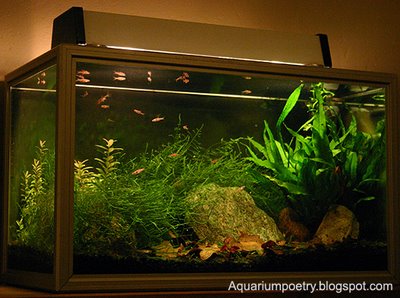 Fauna; Rasbora maculata, Red Cherry shrimp, Crystal Red shrimp, Malaysian Trumpet snail and Red Ramshorn snail.
Fauna; Rasbora maculata, Red Cherry shrimp, Crystal Red shrimp, Malaysian Trumpet snail and Red Ramshorn snail.


They go crazy for it and are showing great color and reproductive capacity ;-) Baby shrimps are all over the tank. The Java moss is beautifully taking over the aquarium. I have to trim it every two weeks.
Mature set-up ;
 Newly established set-up ;
Newly established set-up ; As you can see on those two photos above, the tank did mature alot. The Java moss is beautifully taking over. I will leave it for one more month before I trim it back. Too much of Java moss will choke the whole tank. There are some good news since my last posting. All females are carrying eggs and there are many baby shrimps around the tank. The shrimplets are feeding exclusively of off the glass walls and filter sponge. They can be spot on plant leaves but not on the withered oak leaves. It is sure that their main diet are microorganisms, bacteria and algae. I feed the mature shrimps with very little algae flake (three flakes for 12 shrimps) every day. One day fasting. One of my mature females died a few days ago and was eaten by the Malaysian Trumpet snails in about two days. There are lots of snails, so I presume there is lots of microorganisms for them to feed on, because I am not overfeeding this tank but rather underfeeding. At all times the shrimps and snails are picking up on something from the glass, plants, stones, etc.
As you can see on those two photos above, the tank did mature alot. The Java moss is beautifully taking over. I will leave it for one more month before I trim it back. Too much of Java moss will choke the whole tank. There are some good news since my last posting. All females are carrying eggs and there are many baby shrimps around the tank. The shrimplets are feeding exclusively of off the glass walls and filter sponge. They can be spot on plant leaves but not on the withered oak leaves. It is sure that their main diet are microorganisms, bacteria and algae. I feed the mature shrimps with very little algae flake (three flakes for 12 shrimps) every day. One day fasting. One of my mature females died a few days ago and was eaten by the Malaysian Trumpet snails in about two days. There are lots of snails, so I presume there is lots of microorganisms for them to feed on, because I am not overfeeding this tank but rather underfeeding. At all times the shrimps and snails are picking up on something from the glass, plants, stones, etc.
 The good news is one of the Cherry shrimps is carrying eggs, which was a pleasure to see.
The good news is one of the Cherry shrimps is carrying eggs, which was a pleasure to see. The bad news is that the same female dropped the eggs the same day :-( and I still don't have a clue what is causing this problem. On the photo one can see the female dropping the eggs, but she left a few. I hope they stay in the pleopods and become baby's soon.
The bad news is that the same female dropped the eggs the same day :-( and I still don't have a clue what is causing this problem. On the photo one can see the female dropping the eggs, but she left a few. I hope they stay in the pleopods and become baby's soon. And just before I decided to post the photos above, I looked at the aquarium and saw one of the female Cherrys feeding on the power head...but that wasn't all !!! I had to get closer to the tank, because I had a feeling something tiny was moving beside that shrimp... SHOCK !!! I had a feeling it was some kind of worm or something but not a tiny baby Cherry shrimp!!! Yes it was a baby shrimp, behaving the same way as the adults do, AMAZING !!! I am so pleased with this news. I don't know how this is possible since I am observing them daily. The first carrying female must have left a few eggs that I wasn't aware of. This is a great proof that my only one male is performing good !!! BTW, the miniature shrimp is approx 3mm long. To see the Red Cherry shrimplet video click here.
And just before I decided to post the photos above, I looked at the aquarium and saw one of the female Cherrys feeding on the power head...but that wasn't all !!! I had to get closer to the tank, because I had a feeling something tiny was moving beside that shrimp... SHOCK !!! I had a feeling it was some kind of worm or something but not a tiny baby Cherry shrimp!!! Yes it was a baby shrimp, behaving the same way as the adults do, AMAZING !!! I am so pleased with this news. I don't know how this is possible since I am observing them daily. The first carrying female must have left a few eggs that I wasn't aware of. This is a great proof that my only one male is performing good !!! BTW, the miniature shrimp is approx 3mm long. To see the Red Cherry shrimplet video click here.
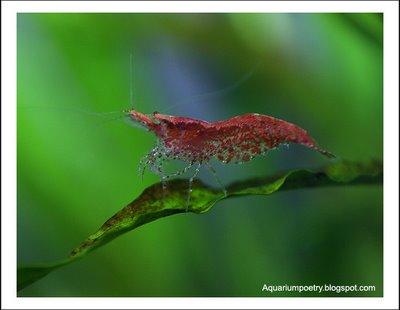 I am very happy to see my female Red Cherrys becoming more red. Young females are known to be more pale, but after each moulting the are turning more red. And because of that I am starting to realise that I probably have only ONE MALE !!! I just hope this little guy can fertilise all the females...hm. I believe I am better off buying another male or two. The next two photos are showing the one male I have. RCS males are very pale with very little red on the top of their abdomen, and that is more like red dots. The abdomen shape is not as deep as the females is. If you take a closer look (the first female photo) you will notice that the females abdomen is rather deep, so it can store and protect the eggs. I am 99% sure that the pale shrimp is male. Time will tell.
I am very happy to see my female Red Cherrys becoming more red. Young females are known to be more pale, but after each moulting the are turning more red. And because of that I am starting to realise that I probably have only ONE MALE !!! I just hope this little guy can fertilise all the females...hm. I believe I am better off buying another male or two. The next two photos are showing the one male I have. RCS males are very pale with very little red on the top of their abdomen, and that is more like red dots. The abdomen shape is not as deep as the females is. If you take a closer look (the first female photo) you will notice that the females abdomen is rather deep, so it can store and protect the eggs. I am 99% sure that the pale shrimp is male. Time will tell. 
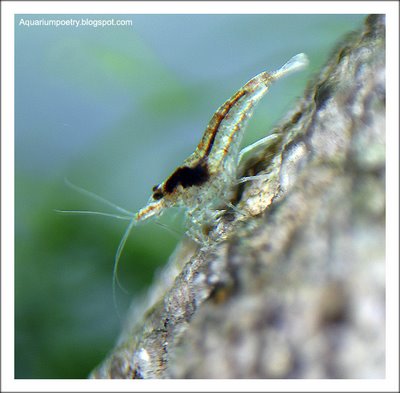 I fed my Neocaridina denticulata sinensis with cooked carrots but they didn't spend much time eating it. They rather feed off of the aquarium glass and from the Oak leaf litter. I am observing them very closely for the last few weeks and I believe that their main diet is formed out of microorganisms, algae and fungus, rather than boiled veggies and algae wafers. Just a few days ago, I fed them with a small piece of algae wafer but they didn't eat all of it, instead they were picking "things" from the stones, leaf litter, glass, filter, plants and gravel. I am prity sure shrimps will do much better in mature set-ups, where aquarium mulm has been formed.
I fed my Neocaridina denticulata sinensis with cooked carrots but they didn't spend much time eating it. They rather feed off of the aquarium glass and from the Oak leaf litter. I am observing them very closely for the last few weeks and I believe that their main diet is formed out of microorganisms, algae and fungus, rather than boiled veggies and algae wafers. Just a few days ago, I fed them with a small piece of algae wafer but they didn't eat all of it, instead they were picking "things" from the stones, leaf litter, glass, filter, plants and gravel. I am prity sure shrimps will do much better in mature set-ups, where aquarium mulm has been formed.
 And since they enjoy eating microorganisms from the Oak leaf litter, I collected some more from a near by park. I am soaking them in a bit of dechlorinated water, so they sink readily. The more leaf litter, the more surfaces for the microorganisms to grow on. I will try to collect more withered Oak leaves before the season is over.
And since they enjoy eating microorganisms from the Oak leaf litter, I collected some more from a near by park. I am soaking them in a bit of dechlorinated water, so they sink readily. The more leaf litter, the more surfaces for the microorganisms to grow on. I will try to collect more withered Oak leaves before the season is over.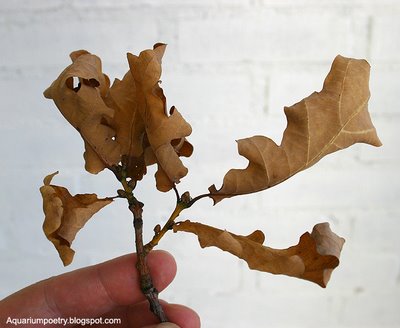 Photos by Dusko Bojic.
Photos by Dusko Bojic.
Another female lost the eggs. I can see one carrying only 2-3 eggs, how sad. I am not sure what is causing them to release the eggs so soon. Is it possible that those two male RCS can't fertilise???


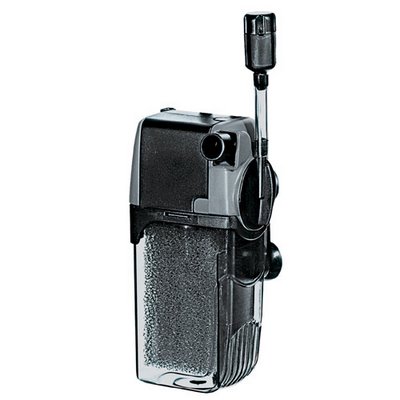
Today I found one of my shrimps dead amongst Java moss.
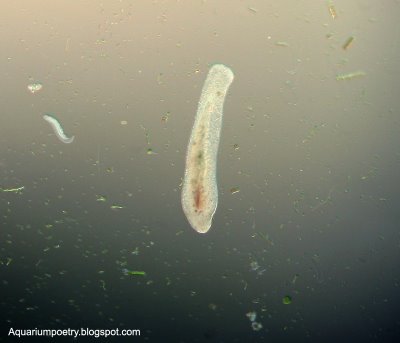 I discovered that the Oligochaetes spp. is not the only worm I have in this tank. I have quiet a lot of those Flatworms shown on this photo above. They glide very fast for a 1.5 mm creature.
I discovered that the Oligochaetes spp. is not the only worm I have in this tank. I have quiet a lot of those Flatworms shown on this photo above. They glide very fast for a 1.5 mm creature.

 On the last photo beside the Oligochaetes spp. one can see long hairy algae. That is cyanobacteria aka the Blue Green Algae. It is impossible to see it with bare eyes.
On the last photo beside the Oligochaetes spp. one can see long hairy algae. That is cyanobacteria aka the Blue Green Algae. It is impossible to see it with bare eyes.
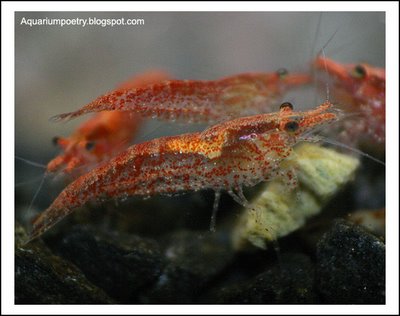 Two days ago I discovered few RCS females having white saddles forming in their carapace and spreading into the abdomen, dorsally (producing eggs, see the 1st photo). In the beginning I had a feeling that I got 9 males and 1 female, but now I am quiet sure that it is the other way around. Some females are not that red which is confusing with sex ID, but the white saddle makes it clear now.
Two days ago I discovered few RCS females having white saddles forming in their carapace and spreading into the abdomen, dorsally (producing eggs, see the 1st photo). In the beginning I had a feeling that I got 9 males and 1 female, but now I am quiet sure that it is the other way around. Some females are not that red which is confusing with sex ID, but the white saddle makes it clear now. Photos by Dusko Bojic
Photos by Dusko Bojic
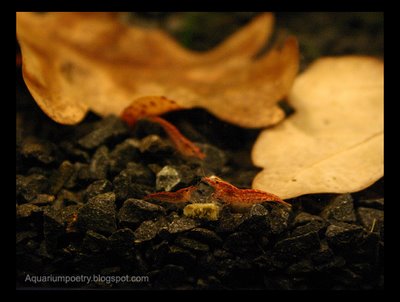 Toady a realised that I probably have more than one female. They are more red today as they settled down. All 10 of my Red Cherrys are active in search for food, and picking up "things" from stones and plants. Just in a case that they were starved in the LFS, I fed them with a very small piece of the HIKARY Algae Wafers, which they seem to like. My plan is to feed them with algae wafers two to three times a week. I am not sure should I feed them with other food types in between. I would rather have them eat the algae and the microorganisms that are growing inside the tank.
Toady a realised that I probably have more than one female. They are more red today as they settled down. All 10 of my Red Cherrys are active in search for food, and picking up "things" from stones and plants. Just in a case that they were starved in the LFS, I fed them with a very small piece of the HIKARY Algae Wafers, which they seem to like. My plan is to feed them with algae wafers two to three times a week. I am not sure should I feed them with other food types in between. I would rather have them eat the algae and the microorganisms that are growing inside the tank.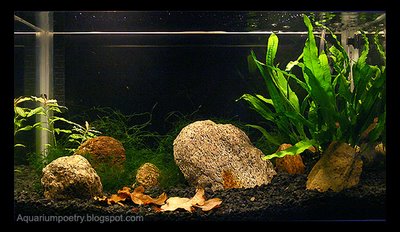 The Oak leaves fit very good into this aquascape of mine. I will probably add some more. The Java Moss is providing lots of shelter places for the baby shrimp to hide in. Today I measured the shrimps and they are between 1-1.5cm in length. They are still very young.
The Oak leaves fit very good into this aquascape of mine. I will probably add some more. The Java Moss is providing lots of shelter places for the baby shrimp to hide in. Today I measured the shrimps and they are between 1-1.5cm in length. They are still very young.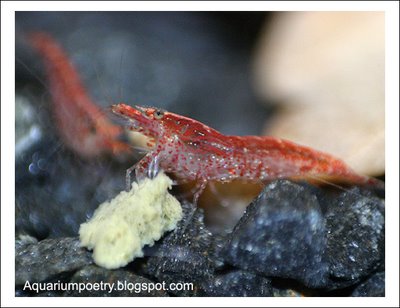 Water pH is 7.8 with hardness of KH 5. Temperature is at 26'C. These water parameters should favour breeding conditions. I measured for nitrIte today and it is on 0ppm.
Water pH is 7.8 with hardness of KH 5. Temperature is at 26'C. These water parameters should favour breeding conditions. I measured for nitrIte today and it is on 0ppm.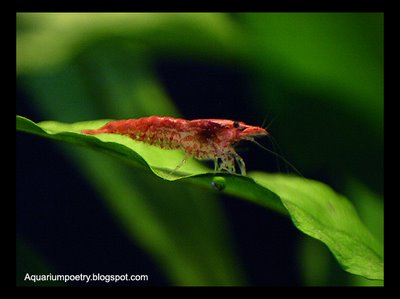 I made a bit better photos today, but still far from satisfying :-(
I made a bit better photos today, but still far from satisfying :-(